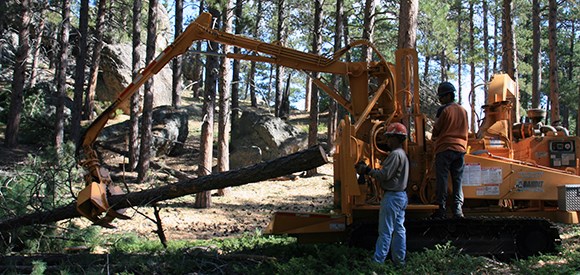Last updated: January 18, 2017
Article
Wildland Fire: Reducing Crown Fire Potential and Mountain Pine Beetle Infestation

In February 2010, staff at Mount Rushmore National Memorial requested assistance from the Midwest Regional Office. The park asked the regional office to help prepare a plan to mitigate the impacts of a potential mountain pine beetle infestation and to reduce the crown fire potential at the memorial. The plan was completed by a small group of specialists with input from memorial staff, the Black Hills National Forest, and other local stakeholders.
Mount Rushmore National Memorial has an extensive ponderosa pine forest, much of it old-growth, that hasn’t had a landscape-scale fire since 1893. The elimination of fire changed the historically open, heterogeneous forest structure to one that consisted primarily of closed stands with high densities of young trees. Higher tree density and ladder fuels increased the risk of stand-replacing crown fire at the memorial. To reduce the potential for crown fire and mountain pine beetle infestation, two thinning treatments were implemented in the summer and fall of 2010. On the first thin and pile treatment areas nearly all ponderosa pine trees that were six-inches in diameter or less were cut and piled to be burned during the winter. The second treatment included cutting nearly all ponderosa pine trees that were ten-inches in diameter or less and chipping the material on site. More than 500 acres--roughly 43 percent of the memorial--were thinned by mid to late fall 2010. National Park Service vegetation monitoring crews installed forest monitoring plots prior to this project’s implementation and revisited the same plots in summer 2012 to assess the effect on forest structure and to model the effectiveness of the thinning in reducing crown fire potential.
The density of ponderosa pine trees less than seven inches in diameter decreased by an average of 78 percent in the thin and pile treatment unit. The density of ponderosa pine trees less than seven inches in diameter decreased by an average of 87 percent in the thin and chip treatment unit.
Removing most of the smaller trees greatly reduced the potential for a stand-replacing crown fire within the memorial, primarily due to the significant reduction in ladder fuels. Crown fire potential was modeled pre- and post-treatment at the memorial. Initial fire behavior modeling indicated a significant reduction in crown fire as a result of the treatments.
Including areas that were treated between 2003 and 2009, 62 percent of the memorial has now been mechanically thinned. In the thin and pile treatment units, piles were burned during the past two winters on approximately 185 acres of the memorial. Ultimately, it is the hope that these treatments will make the forest more resilient and resistant to infestation of mountain pine beetle, and also expand the opportunities for fire managers to complete prescribed fire treatments at the memorial.
Contact: Dan Swanson, Northern Great Plains fire ecologist
E-Mail: e-mail us
Phone: (605) 745-1172
